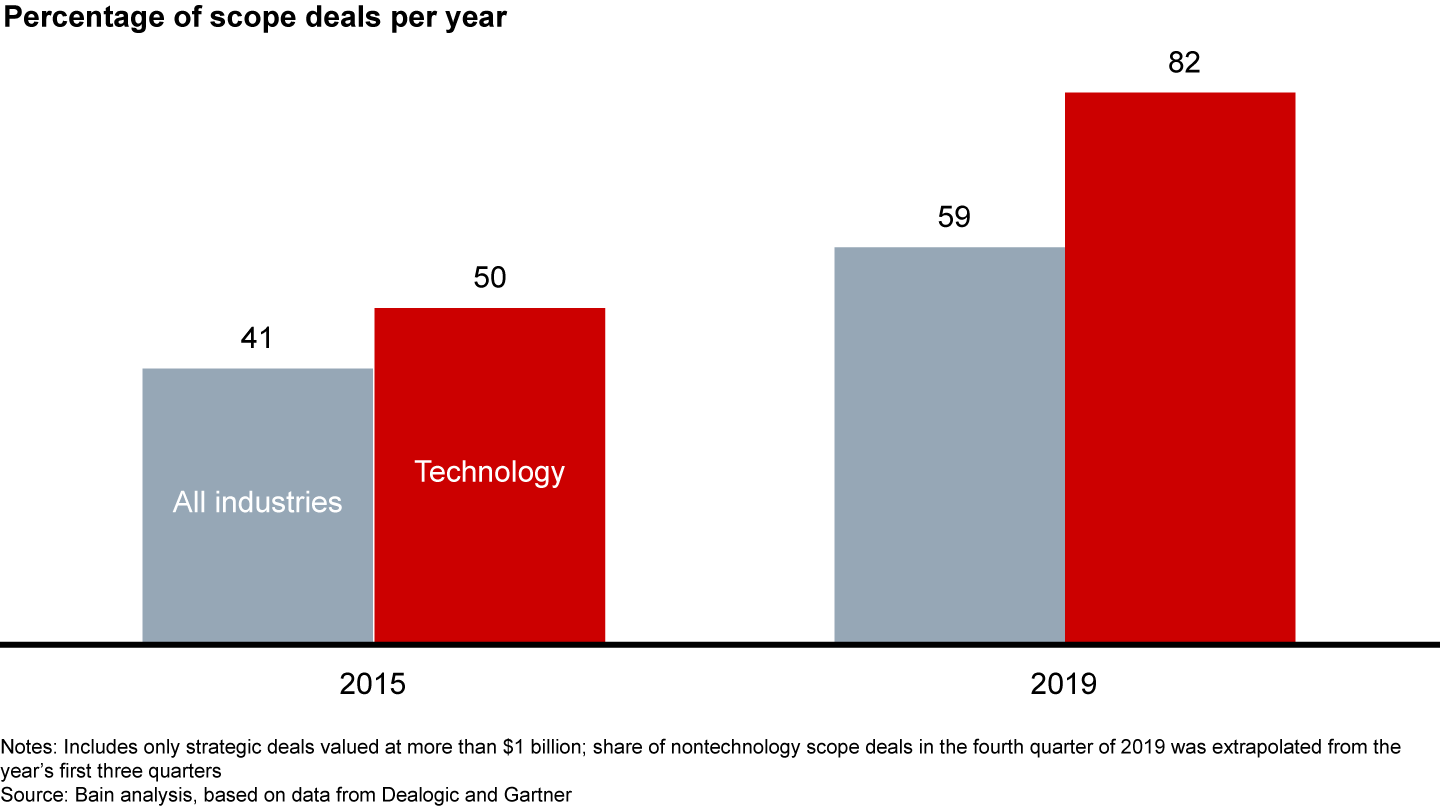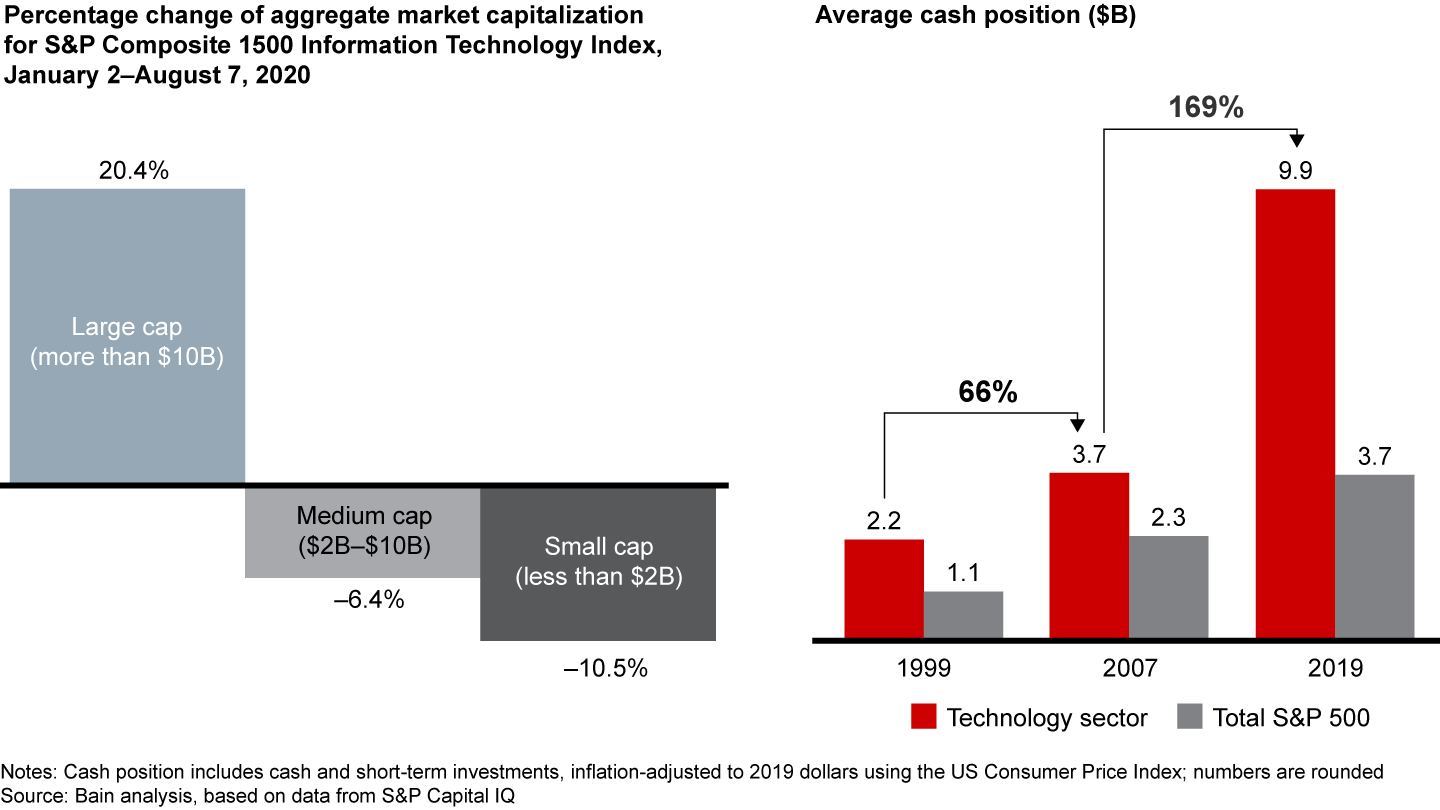Rapport

This article is Chapter 13 of Bain’s global Technology Report 2020. Explore the contents of the report here or download the PDF to read the full report.
Over the past five years, the fundamental thesis for technology mergers and acquisitions has changed. Now, the vast majority are geared toward one thing: expanding the scope of the business.
In 2019, 82% of technology mergers and acquisitions were scope deals, through which the buyer enters faster-growing business segments or acquires new capabilities, intellectual property or talent to generate future growth. The rest were scale deals typically aimed at strengthening the company’s market position and reducing costs.
Just five years ago, there was an even split between scope and scale deals in the technology industry (see Figure 1).

This growing pursuit of scope acquisitions is happening in all sectors, but it’s much more pronounced in technology. Scope transactions for all industries grew from 41% in 2015 to 59% in 2019.
The emphatic swing toward scope deals in technology is one way that companies are positioning themselves to keep up with unprecedented rates of technology transitions, shifting boundaries of competition, expanding customer expectations and a fierce talent war.
A key to successful scope deals is adding capabilities that improve the value proposition of a company’s existing business. Salesforce’s $16.3 billion purchase of Tableau Software last year gave customers access to Tableau’s data visualization platform, which strengthened the analytics capabilities of Salesforce’s customer relationship management offering. Scope M&A can also help companies diversify revenue sources and expand into new markets. This year, Infineon Technologies acquired Cypress Semiconductor for $10 billion to add microcontrollers and connectivity products to its lineup of offerings. This broadened Infineon’s customer base and gave it new cross-selling opportunities. Analysts expect the deal to achieve €750 million of annual revenue synergies by 2025. And some scope deals accomplish both aims: They add capabilities and move the company into faster-growing segments.
The other reason for the shift toward scope deals is structural. Simply put, there are fewer opportunities for scale acquisitions these days because the technology sector has become highly concentrated. Segments such as semiconductors and software have gone through years of consolidation. Other areas, such as cloud services, are inherently prone to a small number of winners.
This scope M&A bent will likely accelerate. Technology deals came to a standstill in the second quarter of this year, due to the Covid-19 pandemic and tightening credit markets. But the landscape is ripe for renewed M&A activity. Many technology companies’ share prices have been resilient during the recent economic downturn, and they’re sitting on large cash reserves that could fund deals (see Figure 2). Those with the means will use this opportunity to add new capabilities and reposition their organizations for the postpandemic world.

This was the case during the Great Recession. Technology deal volume increased 9% from 2007 to 2010. Several technology companies inked strategic scope acquisitions during the downturn. For example, Adobe laid the foundation for its transition to a cloud-enabled business with its 2009 acquisition of web analytics company Omniture for $1.8 billion.
How to get the most out of the deal
The powerful benefits of scope deals come with a price, of course. They’re typically more expensive than scale deals and deliver fewer cost benefits. From 2015 through 2019, technology scope deal premiums were 51% higher than scale acquisitions, and cost synergies were 42% lower than for scale deals during that period. Once again, this trend is true across all sectors, but is more pronounced in technology. Part of the reason for the disparity is that synergies in scope deals are typically more revenue-based, often less controllable for the buyer than concrete cost synergies frequently targeted in scale acquisitions. In addition, scope deals tend to target innovative companies working in rapidly growing sectors, so the acquired company has more leverage to demand a higher premium.
In addition, scrutiny of technology deals is intensifying as regulatory oversight evolves beyond issues of market concentration to include consumer data and privacy, national interest and security, and future competition. All of this places greater demands on preparing for consultations with regulators and broader stakeholder communications during the deal diligence and negotiation phases.
The most successful scope deals start with proper screening. Leading companies proactively and frequently scan sectors for companies that fit their strategy. Once the target is in sight, they develop a bespoke integration strategy that articulates precisely what should—and, just as important, should not—be integrated in order to realize the expected deal value. There must be alignment among the leadership team for the plan to work.
This is where many scope deals go wrong. Buyers have a tendency to overintegrate the acquired company. Some purchasers apply their well-honed processes, operating model and overhead levels on what is often a very different business model, which can have the unintended consequences of squashing the acquired company’s capabilities or even putting its business at risk.
Business integration teams typically don’t have extensive experience with scope M&A. So, once a deal closes, leading companies assign senior general managers to provide extra oversight and assistance to ensure the integration goes as planned.
Lastly, don’t forget about the people. Culture clashes between the two organizations can lead to business stagnation, loss of focus and talent defection. All of a sudden, acquirers can find they have unwittingly diminished the value of the new asset.
The most successful scope buyers spend as much time and effort on retaining talent and smoothly combining teams with different cultures as they do on hitting financial targets. Getting this right can be the difference between a bad deal and a good one—or even a massive success.

